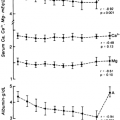ENDOMETRIOSIS LESIONS ARE STEROID RESPONSIVE
Part of “CHAPTER 98 – ENDOMETRIOSIS“
Mechanical (retrograde menstruation) and endocrine factors (estradiol, progesterone) contribute to the development of endometriosis lesions. In most women, the majority of menstrual effluent leaves the uterus through the cervical os, thereby entering the vagina.3 In women with a reduced cervical os diameter, significant amounts of menstrual effluent exit the uterus through the fallopian tubes, thereby entering the peritoneal cavity.4 The process of “retrograde” menstruation results in the transportation of small fragments of viable endometrium into the peritoneal cavity, where they can become implanted and grow. Women with endometriosis appear to have an eutopic endometrium, which has greater potential for implantation at distant sites than does that from women without endometriosis.5
Hemocrine, paracrine, and autocrine factors play major roles in regulating the growth of endometriosis lesions. The major endocrine regulators of endometriosis lesions are the steroid hormones, estrogen, androgens, and progestins.6 Estrogens stimulate the growth of endometriosis lesions, whereas androgens inhibit lesion growth. The major paracrine and autocrine factors that regulate endometriosis lesions are cytokines7,7a and growth factors.8 Endometriosis lesions are associated with the excessive secretion of chemotactic factors9,10 and 11 and can grow in response to cytokines and growth factors secreted by activated immune cells.12,13
Stay updated, free articles. Join our Telegram channel

Full access? Get Clinical Tree





